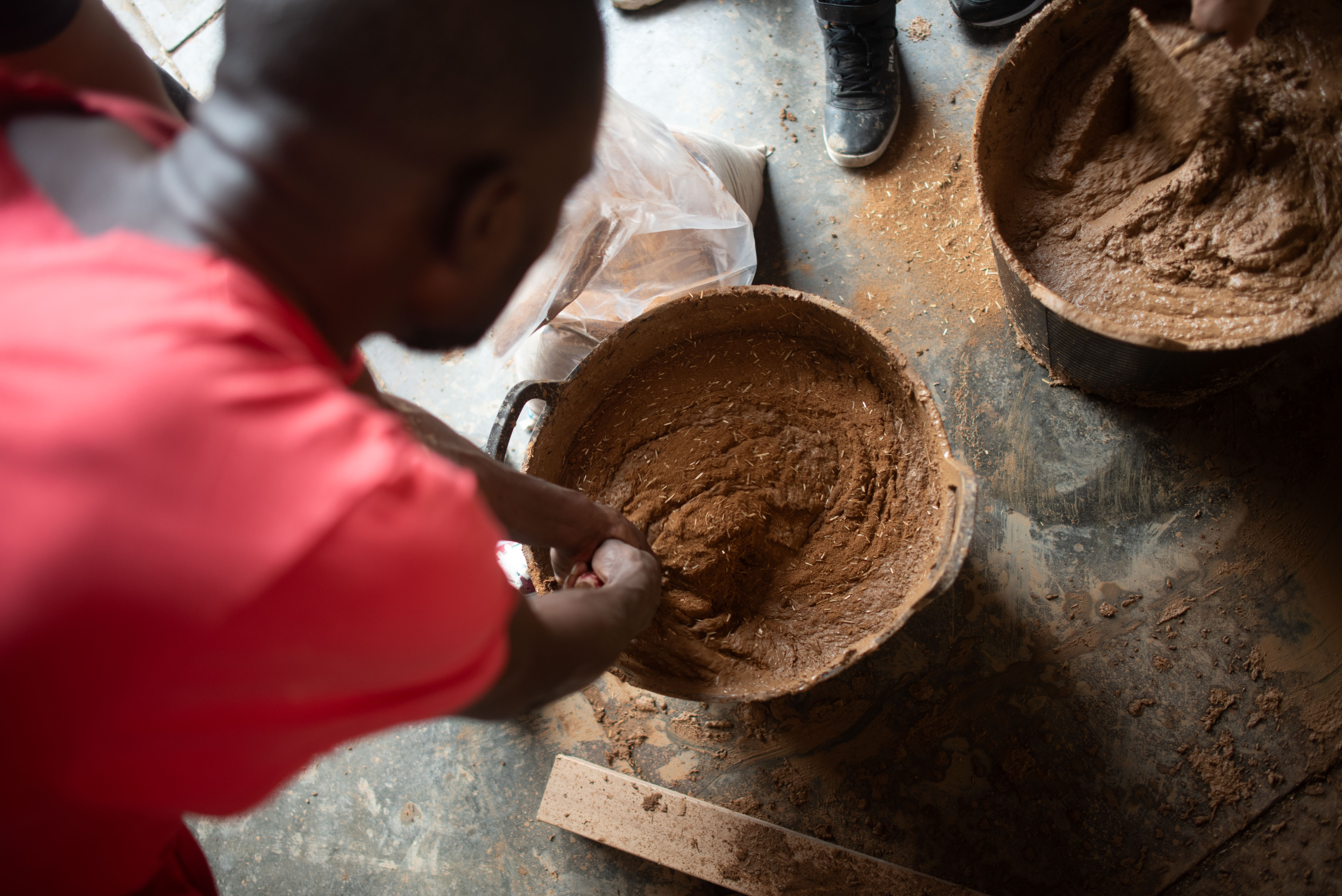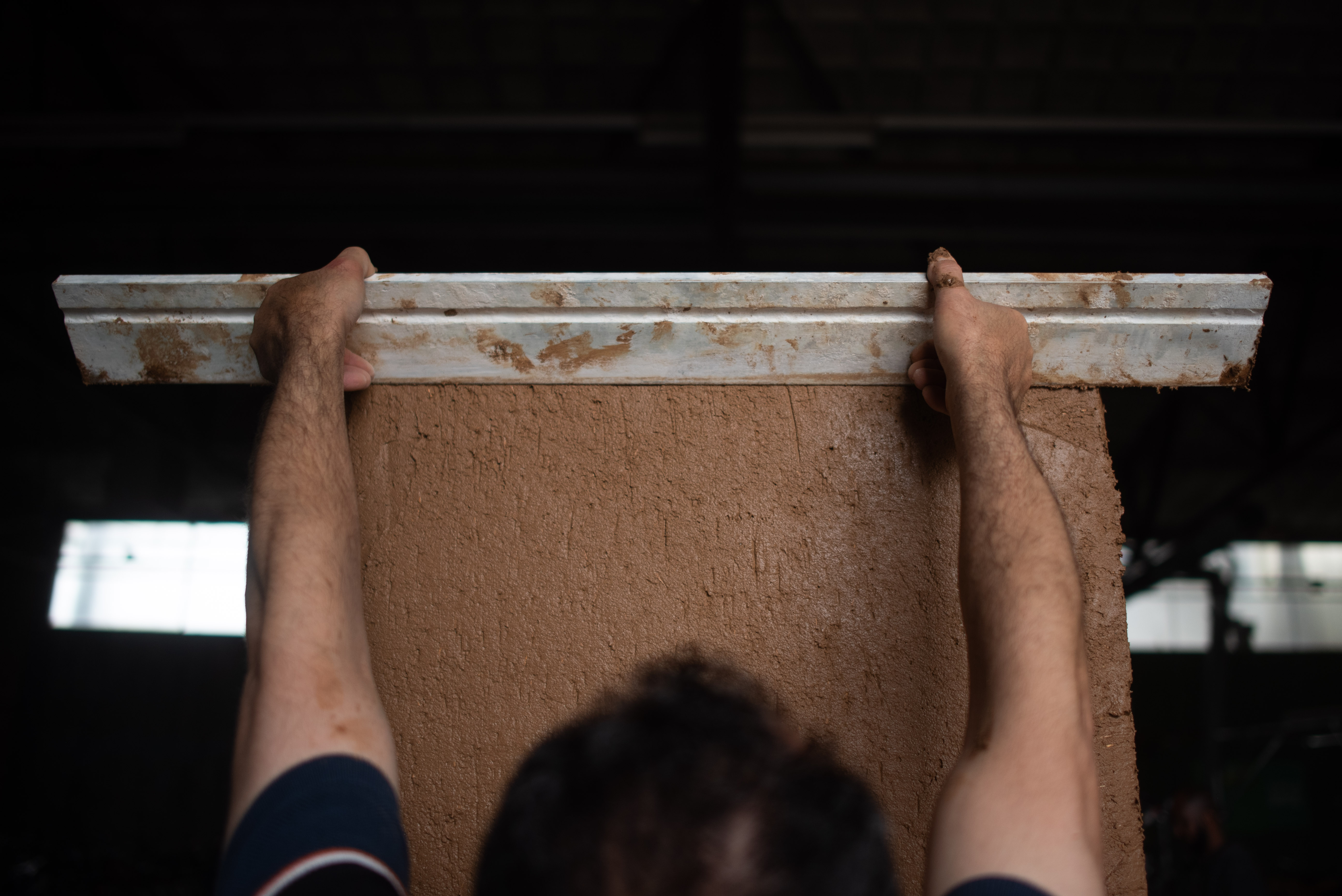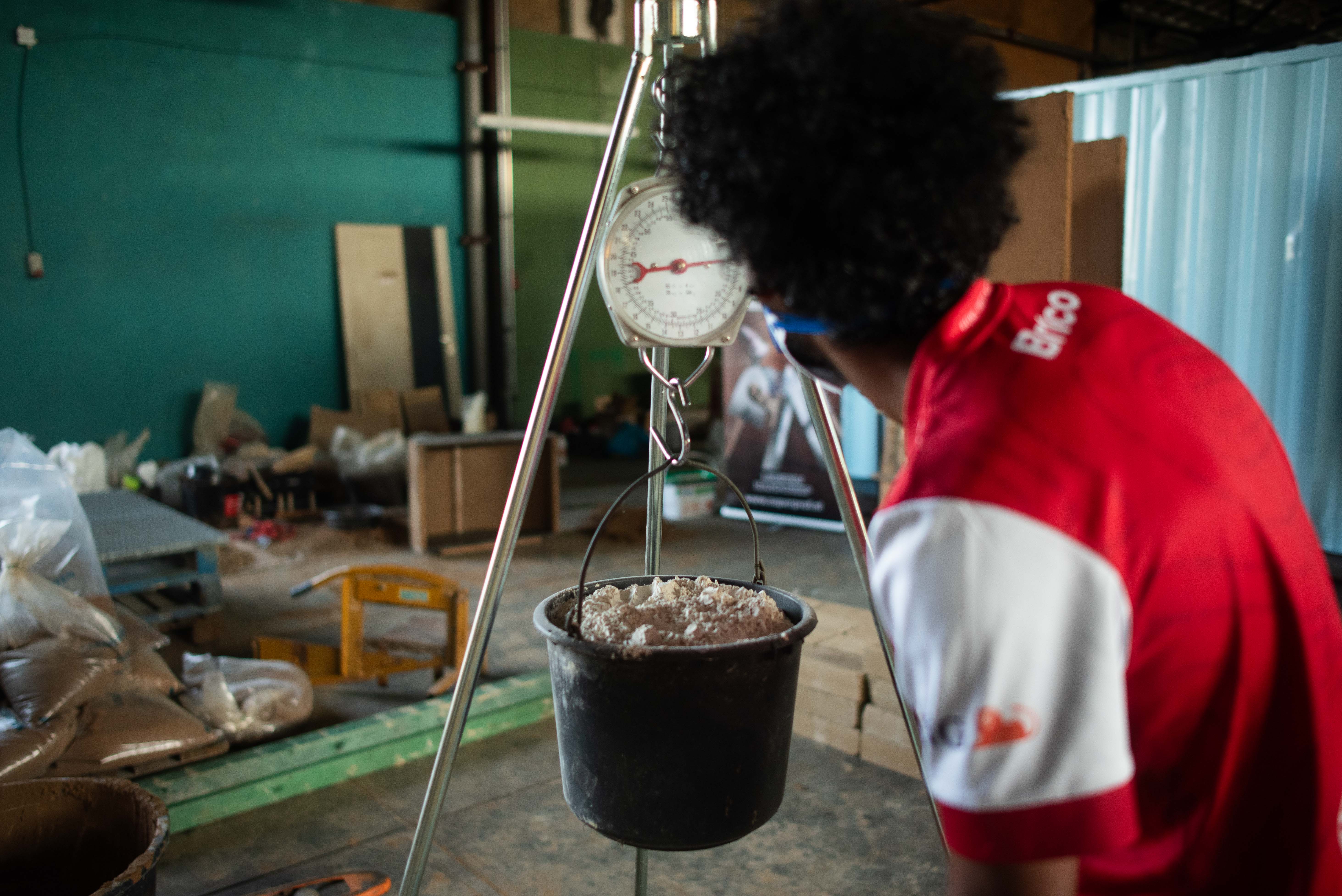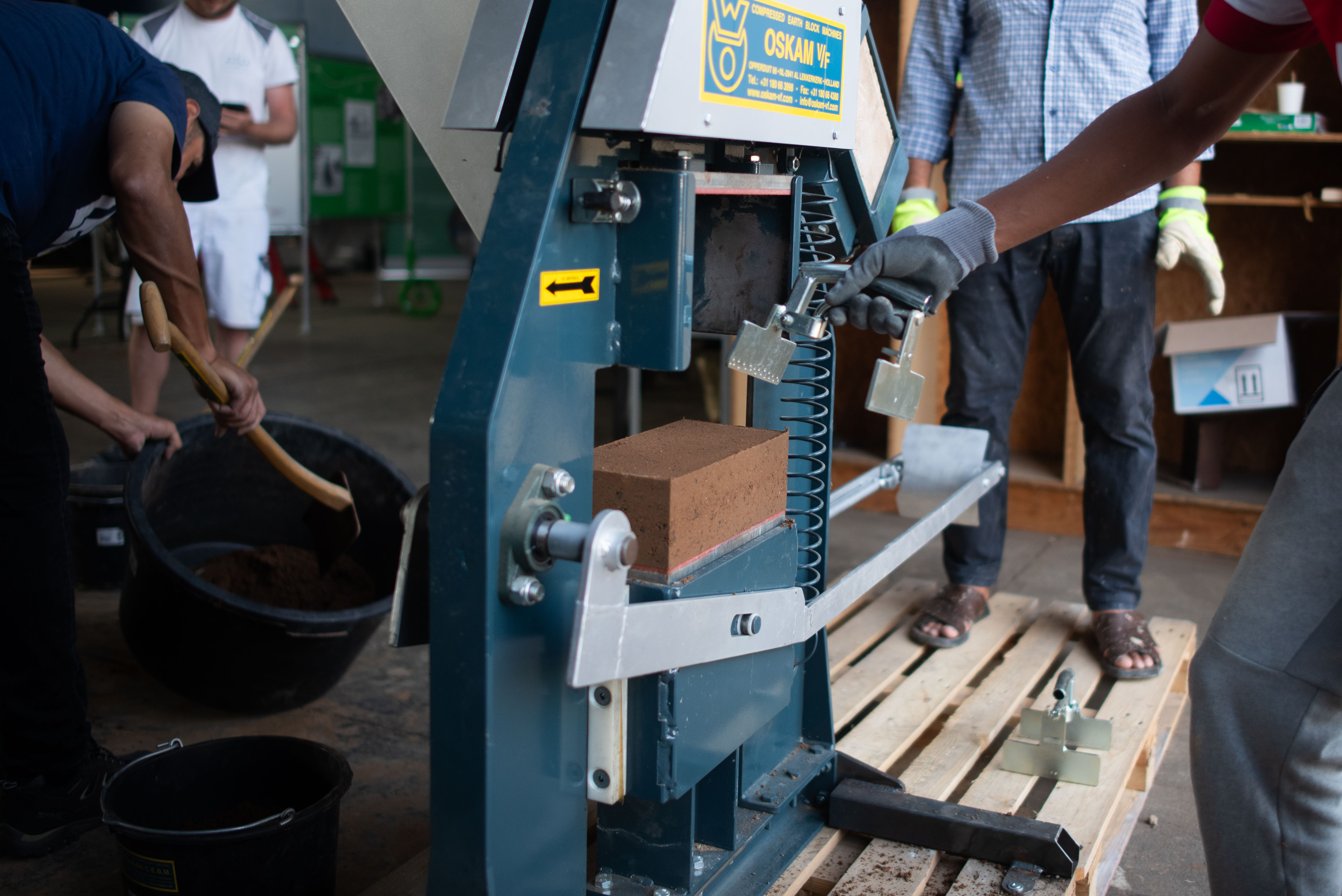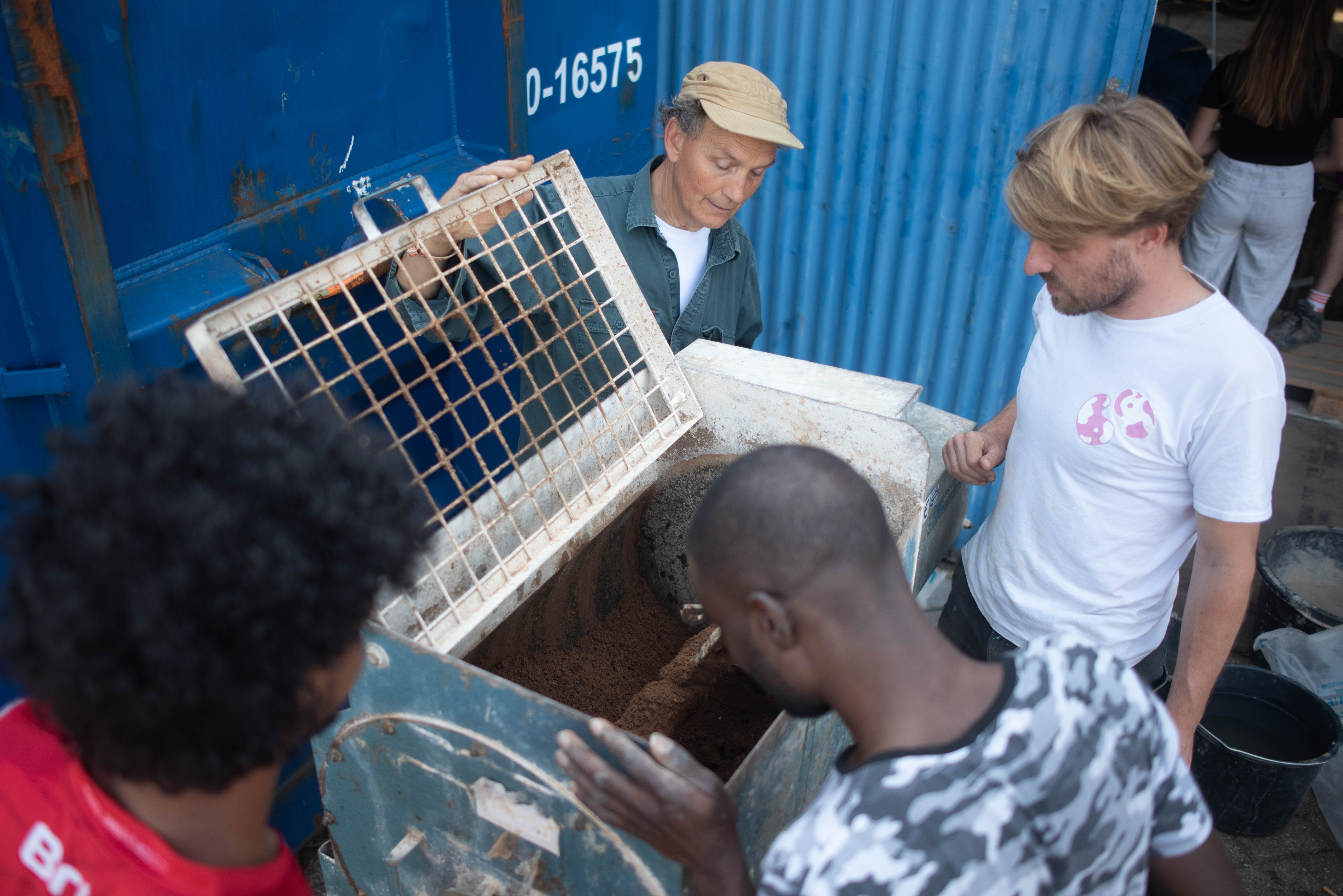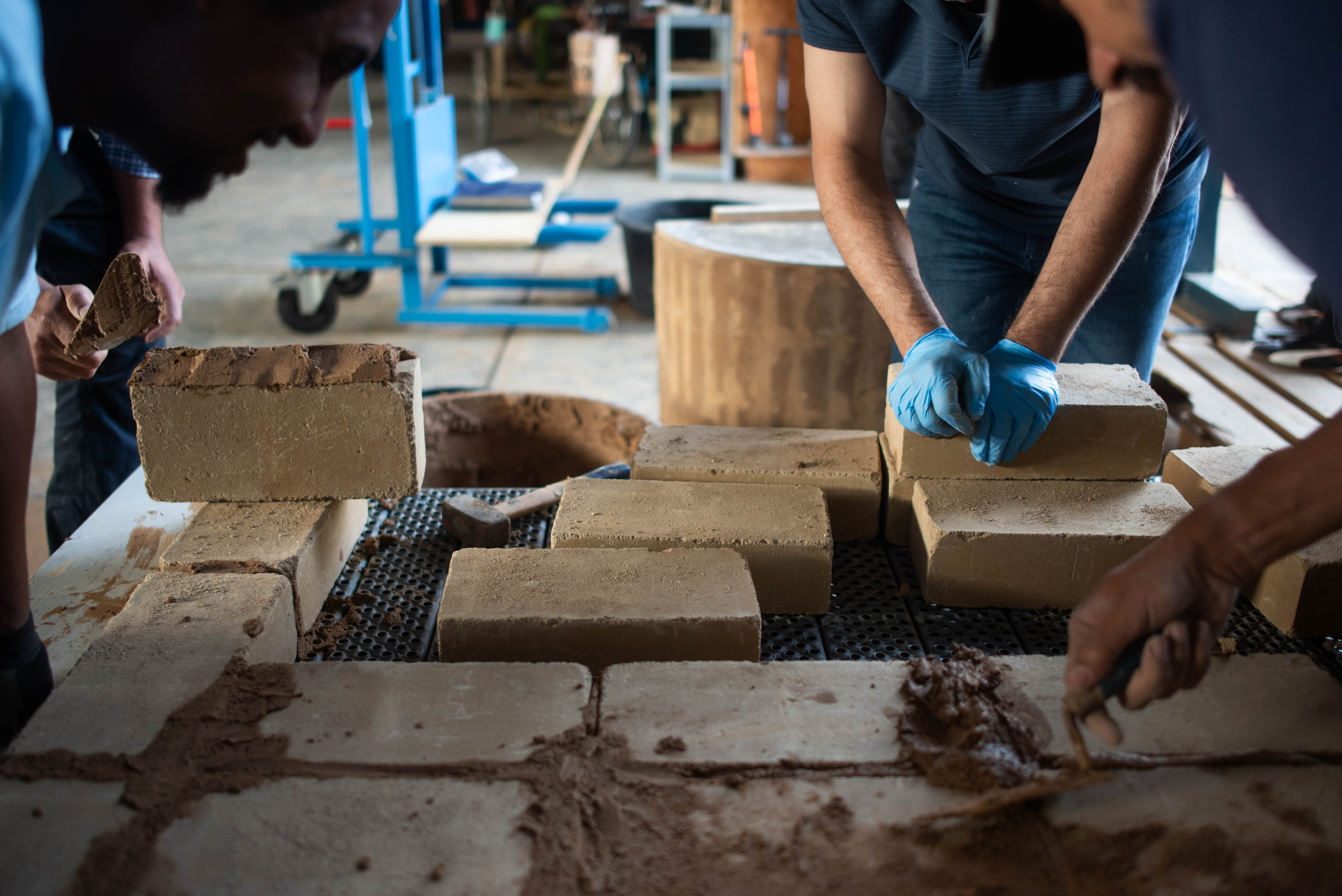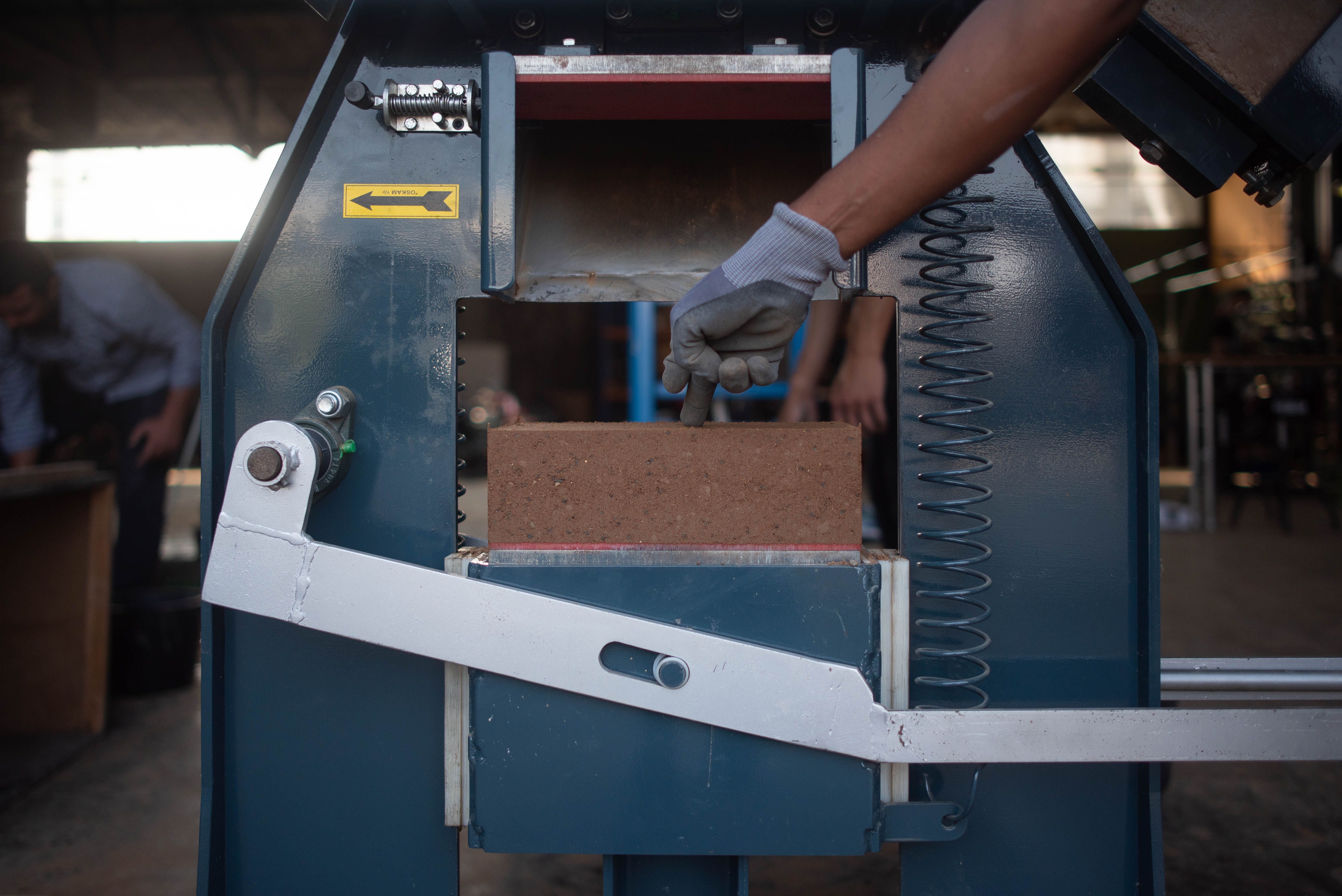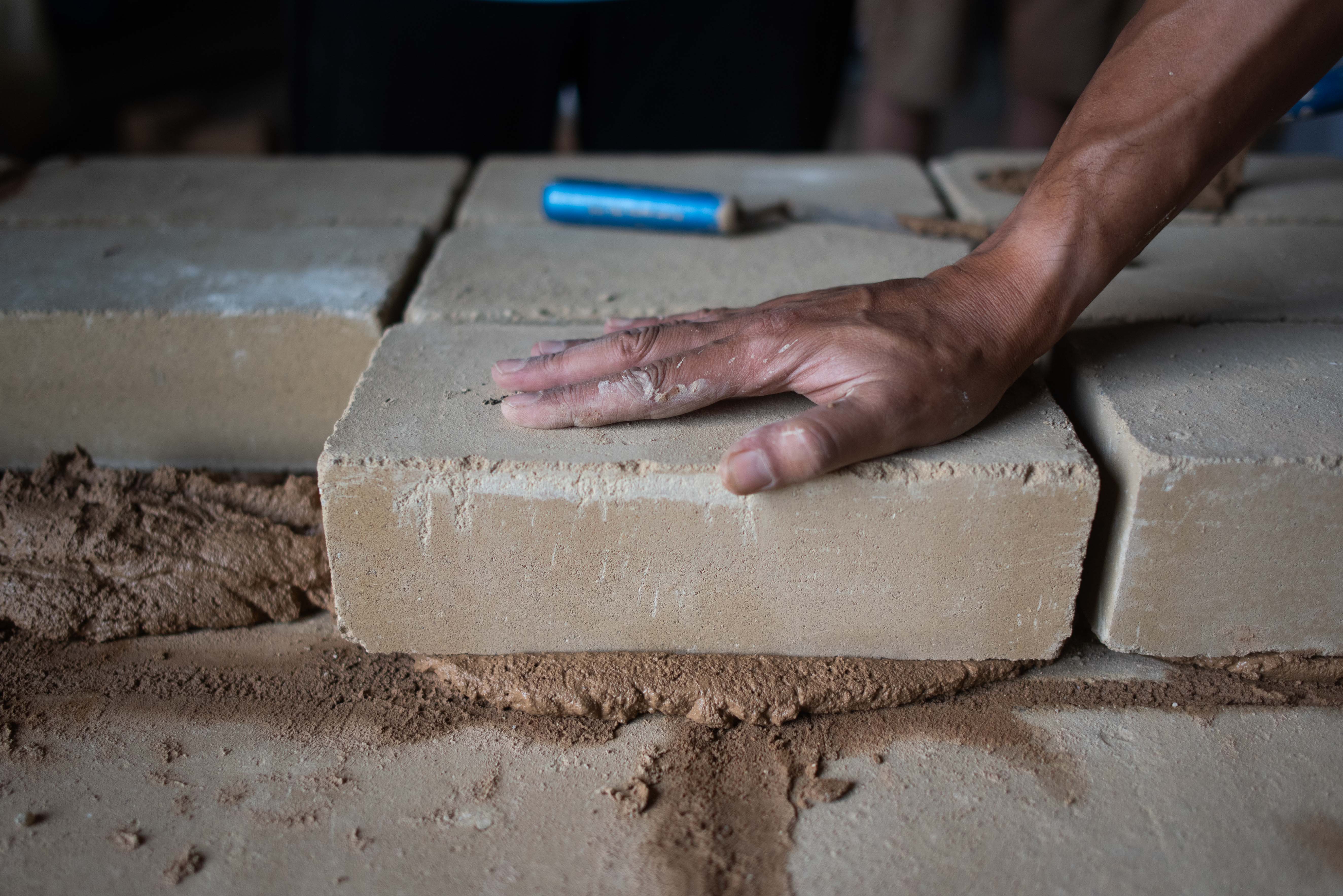Regaining a sense of belonging
Stadsgrond x Newcomers Earth as a binder
Stadsgrond x Newcomers | Earth as a binder, educating newcomers to work with raw earth
Stadsgrond's earth construction workshops in Rotterdam aid newcomers' integration into Dutch society. By teaching them to transform local clay waste from construction sites into building materials, the initiative reduces emissions, creates jobs and fosters cross-cultural exchange of sustainable building practices. Celebrating shared heritage through earth building emphasizes shared values and encourages acceptance and appreciation of cultural differences.
Netherlands
Local
Rotterdam
Mainly urban
It refers to other types of transformations (soft investment)
Yes
2024-10-10
No
No
No
As an individual
Stadsgrond promotes sustainability, cultural exchange, and social integration through earth construction. By transforming Rotterdam’s clay waste into construction materials, we connect newcomers and locals, proving earth is both a resource and a shared language. Our goal is to create sustainable, community-driven solutions that empower newcomers, foster engagement, and promote eco-friendly construction. The project engages migrants, refugees, and local residents in skill-building and knowledge exchange.
Newcomers from earth-building cultures combine ancestral expertise with modern techniques, fostering innovation and preserving heritage. Participants gain construction skills, networks, and business insights, opening employment and entrepreneurship opportunities. Using local clay waste minimizes transport emissions and supports a circular economy. In our Fresh Perspectives project, eight newcomers participated in workshops, transitioning from refugees needing help to recognized experts. The program achieved 100% participation, exceeding typical voluntary programs. They built functional structures, including a rammed earth bench, a pizza oven, and compressed earth blocks. More importantly, the project fostered belonging. As one participant shared: "For the first time in a long period, I didn't feel like a refugee."
The project’s success has led to expansion. Training programs are growing, with advanced technical skills and entrepreneurship pathways. Some participants are exploring businesses using affordable machinery from our partners at Oskam V/F, in the Netherlands or their home countries. Stadsgrond proves integration, sustainability, and economic empowerment go hand in hand. By working with newcomers rather than for them, we turn diversity into strength—building both sustainable structures and resilient communities.
Newcomers from earth-building cultures combine ancestral expertise with modern techniques, fostering innovation and preserving heritage. Participants gain construction skills, networks, and business insights, opening employment and entrepreneurship opportunities. Using local clay waste minimizes transport emissions and supports a circular economy. In our Fresh Perspectives project, eight newcomers participated in workshops, transitioning from refugees needing help to recognized experts. The program achieved 100% participation, exceeding typical voluntary programs. They built functional structures, including a rammed earth bench, a pizza oven, and compressed earth blocks. More importantly, the project fostered belonging. As one participant shared: "For the first time in a long period, I didn't feel like a refugee."
The project’s success has led to expansion. Training programs are growing, with advanced technical skills and entrepreneurship pathways. Some participants are exploring businesses using affordable machinery from our partners at Oskam V/F, in the Netherlands or their home countries. Stadsgrond proves integration, sustainability, and economic empowerment go hand in hand. By working with newcomers rather than for them, we turn diversity into strength—building both sustainable structures and resilient communities.
Earth building
Newcomers
Multi-crossover
A good start
Hyperlocal
Our project applies sustainable construction through intentional localization. By sourcing earth materials directly from Rotterdam’s urban development sites, we eliminate long-distance transportation, reducing both costs and emissions. This not only benefits the environment but also strengthens local economies and fosters community engagement, aligning with New European Bauhaus principles of sustainability, inclusivity, and aesthetics.
Beyond sourcing, our building process is inherently eco-friendly. Earth materials are infinitely reusable, require no chemical additives, and involve minimal processing, creating a zero-waste closed-loop system. This approach reconnects architecture with nature by respecting natural cycles and using materials already present in the urban landscape.
Our project also proves that sustainability and economic viability go hand in hand. Local sourcing isn’t just environmentally responsible—it’s cost-effective. Studies show it can reduce construction costs by up to 20% compared to imported materials. This creates a strong incentive for businesses to adopt greener practices, ensuring environmental responsibility and financial sustainability reinforce each other.
By demonstrating the economic and environmental benefits of earth-based construction, we aim to inspire broader adoption across Europe. Our project supports the EU’s circular economy goals and aligns with the European Green Deal. It serves as a model for regenerative urban development, proving that sustainability can be both practical and scalable.
Earth buildings also provide long-term benefits—they are durable, low-maintenance, and reduce future resource consumption. By promoting local, circular, and nature-based solutions, we contribute to a more resilient and sustainable built environment for generations to come.
Beyond sourcing, our building process is inherently eco-friendly. Earth materials are infinitely reusable, require no chemical additives, and involve minimal processing, creating a zero-waste closed-loop system. This approach reconnects architecture with nature by respecting natural cycles and using materials already present in the urban landscape.
Our project also proves that sustainability and economic viability go hand in hand. Local sourcing isn’t just environmentally responsible—it’s cost-effective. Studies show it can reduce construction costs by up to 20% compared to imported materials. This creates a strong incentive for businesses to adopt greener practices, ensuring environmental responsibility and financial sustainability reinforce each other.
By demonstrating the economic and environmental benefits of earth-based construction, we aim to inspire broader adoption across Europe. Our project supports the EU’s circular economy goals and aligns with the European Green Deal. It serves as a model for regenerative urban development, proving that sustainability can be both practical and scalable.
Earth buildings also provide long-term benefits—they are durable, low-maintenance, and reduce future resource consumption. By promoting local, circular, and nature-based solutions, we contribute to a more resilient and sustainable built environment for generations to come.
Earth Construction: A New Design Language
Earth construction challenges modernist design principles, requiring an architectural approach that integrates contemporary aesthetics with traditional materiality. While modern sustainable architecture has favored lightweight timber structures, earth’s structural properties call for different design solutions rooted in historical building traditions.
Our project explores this balance by highlighting earth’s unique qualities. Rammed-earth walls showcase its layered textures, while handmade bricks reveal a rich natural palette. In collaboration with newcomers, we integrate traditional decorative techniques, such as mosque stucco patterns, and construct earth ovens, reflecting the cultural significance of earthen architecture in Syrian and Egyptian contexts. This process fosters cultural exchange and broadens the design vocabulary of earth-based construction.
The tactile nature of earth enhances the learning experience. Participants engage directly with the material, witnessing its transformation from loose soil to a solid structure. This hands-on approach strengthens understanding, fosters ownership, and reinforces the practicality of earth as a sustainable building material.
Beyond aesthetics, the project demonstrates how traditional techniques can be integrated into contemporary design. Earth serves as a link between past and present, proving that sustainability and cultural heritage can coexist within a modern architectural framework. By incorporating participants’ diverse backgrounds into the design process, we create spaces that respect both material efficiency and cultural identity.
Community engagement is central to the project. Collaborative construction, shared meals, and final gatherings around the pizza oven reinforce a sense of shared purpose. Through this approach, the project exemplifies how sustainable architecture can be both environmentally responsible and socially meaningful.
Earth construction challenges modernist design principles, requiring an architectural approach that integrates contemporary aesthetics with traditional materiality. While modern sustainable architecture has favored lightweight timber structures, earth’s structural properties call for different design solutions rooted in historical building traditions.
Our project explores this balance by highlighting earth’s unique qualities. Rammed-earth walls showcase its layered textures, while handmade bricks reveal a rich natural palette. In collaboration with newcomers, we integrate traditional decorative techniques, such as mosque stucco patterns, and construct earth ovens, reflecting the cultural significance of earthen architecture in Syrian and Egyptian contexts. This process fosters cultural exchange and broadens the design vocabulary of earth-based construction.
The tactile nature of earth enhances the learning experience. Participants engage directly with the material, witnessing its transformation from loose soil to a solid structure. This hands-on approach strengthens understanding, fosters ownership, and reinforces the practicality of earth as a sustainable building material.
Beyond aesthetics, the project demonstrates how traditional techniques can be integrated into contemporary design. Earth serves as a link between past and present, proving that sustainability and cultural heritage can coexist within a modern architectural framework. By incorporating participants’ diverse backgrounds into the design process, we create spaces that respect both material efficiency and cultural identity.
Community engagement is central to the project. Collaborative construction, shared meals, and final gatherings around the pizza oven reinforce a sense of shared purpose. Through this approach, the project exemplifies how sustainable architecture can be both environmentally responsible and socially meaningful.
Our project redefines inclusion by creating a space where newcomers are valued and empowered. Moving beyond traditional integration models, we foster an environment where diverse skills and perspectives shape both the learning process and the final outcome.
Key strategies include:
1. Shifting Perspectives: We use “newcomers” instead of “refugees,” recognizing skills and fostering belonging.
2. Open Access: Workshops welcome all skill levels—enthusiasm is the only prerequisite.
3. Breaking Barriers: Physical work becomes a common language, creating equal footing.
4. Community Building: Earth-based construction fosters collaboration and shared purpose.
5. Utilizing Diverse Skills: Participants contribute based on their strengths, from ramming earth to fine plasterwork, creating a dynamic and inclusive space.
This model is exemplary because it transforms participants into both learners and teachers, creating a ripple effect of knowledge-sharing. The skills gained support sustainable housing solutions both in the Netherlands and abroad.
Beyond skill-building, we foster genuine two-way knowledge exchange. Newcomers introduce traditional earth-building techniques, enriching local practices. By integrating modern tools and business insights, we also create entrepreneurial pathways, empowering participants to apply their skills professionally.
Crucially, this project builds lasting social networks. Shared meals, collaboration, and an open, welcoming atmosphere naturally forge friendships, strengthening community bonds. By prioritizing mutual respect and co-creation, we show that inclusion is not just about access—it’s about agency, contribution, and shared success.
Key strategies include:
1. Shifting Perspectives: We use “newcomers” instead of “refugees,” recognizing skills and fostering belonging.
2. Open Access: Workshops welcome all skill levels—enthusiasm is the only prerequisite.
3. Breaking Barriers: Physical work becomes a common language, creating equal footing.
4. Community Building: Earth-based construction fosters collaboration and shared purpose.
5. Utilizing Diverse Skills: Participants contribute based on their strengths, from ramming earth to fine plasterwork, creating a dynamic and inclusive space.
This model is exemplary because it transforms participants into both learners and teachers, creating a ripple effect of knowledge-sharing. The skills gained support sustainable housing solutions both in the Netherlands and abroad.
Beyond skill-building, we foster genuine two-way knowledge exchange. Newcomers introduce traditional earth-building techniques, enriching local practices. By integrating modern tools and business insights, we also create entrepreneurial pathways, empowering participants to apply their skills professionally.
Crucially, this project builds lasting social networks. Shared meals, collaboration, and an open, welcoming atmosphere naturally forge friendships, strengthening community bonds. By prioritizing mutual respect and co-creation, we show that inclusion is not just about access—it’s about agency, contribution, and shared success.
Our project embodies the New European Bauhaus principle of participation by placing newcomers at the center of the process. Participants were actively involved at multiple levels—from professional development sessions to sharing their expertise in traditional earth-building techniques—ensuring that their knowledge and perspectives directly shaped the project’s outcomes.
This engagement had a profound impact:
Empowerment & Belonging: One participant shared, “For the first time in a long period, I didn’t feel like a refugee.” The project fostered dignity and agency, shifting perceptions from aid recipients to valued contributors.
Cultural Reconnection: By integrating traditional building techniques, participants reconnected with their heritage, strengthening identity and pride.
Professional Growth: Workshops and hands-on activities developed practical skills, opening doors to future opportunities.
Community Building: Strong social networks formed beyond the workshops, creating lasting support systems.
Entrepreneurial Vision: Exposure to modern tools and business insights inspired participants to explore new professional possibilities.
By prioritizing co-creation, our project exemplifies how citizen involvement leads to more inclusive, meaningful, and sustainable outcomes. Newcomers are not just beneficiaries but active agents of change, demonstrating that participatory processes are key to fostering resilient and connected communities.
This engagement had a profound impact:
Empowerment & Belonging: One participant shared, “For the first time in a long period, I didn’t feel like a refugee.” The project fostered dignity and agency, shifting perceptions from aid recipients to valued contributors.
Cultural Reconnection: By integrating traditional building techniques, participants reconnected with their heritage, strengthening identity and pride.
Professional Growth: Workshops and hands-on activities developed practical skills, opening doors to future opportunities.
Community Building: Strong social networks formed beyond the workshops, creating lasting support systems.
Entrepreneurial Vision: Exposure to modern tools and business insights inspired participants to explore new professional possibilities.
By prioritizing co-creation, our project exemplifies how citizen involvement leads to more inclusive, meaningful, and sustainable outcomes. Newcomers are not just beneficiaries but active agents of change, demonstrating that participatory processes are key to fostering resilient and connected communities.
Our project thrives on multi-level stakeholder engagement, fostering collaboration across local, European, and global networks.
Local Engagement:
Rotterdam’s Material Bank: Supplies local earth, minimizing transport costs and environmental impact.
Local Syrian Kitchen: Prepares communal meals, strengthening cultural exchange and community bonds.
Boat Housing Community: Integrates newcomers into the local social fabric, offering housing and support networks.
Workshop Providers: Offer space and resources, ensuring practical implementation.
Municipality: Shows strong interest in the project’s sustainable and inclusive approach, paving the way for future collaborations.
European & Global Engagement:
European Earth-Building Network: Connects the project with expertise, fostering knowledge exchange and best practices.
Stadsgrond’s Expertise: Insights from European workshops enhance project execution.
Rokus Oskam’s Global Network: Provides access to machinery and expertise across 50 countries, showcasing the project’s scalability.
Expert Contributions:
Oskam V/F & Rokus Oskam: Supply machinery, technical expertise, and knowledge on brick production, ensuring efficient and high-quality construction.
Pauline Merlet & Denis: Offer expertise in rammed earth techniques, enhancing technical knowledge.
Lois Vlasblom: Specializes in stucco applications, enriching aesthetic and material aspects.
Erik Vermue: Contributes expertise in compressed earth block (CEB) production, expanding construction methods.
Amr: Facilitates communication between newcomers and the team, ensuring inclusivity.
Added Value:
This multi-level collaboration bridges technical expertise with cultural knowledge, modern equipment with traditional techniques, and local resources with global innovation. The diverse stakeholder engagement leads to creative solutions, enhanced learning experiences, and a model for sustainable, community-driven building practices.
Local Engagement:
Rotterdam’s Material Bank: Supplies local earth, minimizing transport costs and environmental impact.
Local Syrian Kitchen: Prepares communal meals, strengthening cultural exchange and community bonds.
Boat Housing Community: Integrates newcomers into the local social fabric, offering housing and support networks.
Workshop Providers: Offer space and resources, ensuring practical implementation.
Municipality: Shows strong interest in the project’s sustainable and inclusive approach, paving the way for future collaborations.
European & Global Engagement:
European Earth-Building Network: Connects the project with expertise, fostering knowledge exchange and best practices.
Stadsgrond’s Expertise: Insights from European workshops enhance project execution.
Rokus Oskam’s Global Network: Provides access to machinery and expertise across 50 countries, showcasing the project’s scalability.
Expert Contributions:
Oskam V/F & Rokus Oskam: Supply machinery, technical expertise, and knowledge on brick production, ensuring efficient and high-quality construction.
Pauline Merlet & Denis: Offer expertise in rammed earth techniques, enhancing technical knowledge.
Lois Vlasblom: Specializes in stucco applications, enriching aesthetic and material aspects.
Erik Vermue: Contributes expertise in compressed earth block (CEB) production, expanding construction methods.
Amr: Facilitates communication between newcomers and the team, ensuring inclusivity.
Added Value:
This multi-level collaboration bridges technical expertise with cultural knowledge, modern equipment with traditional techniques, and local resources with global innovation. The diverse stakeholder engagement leads to creative solutions, enhanced learning experiences, and a model for sustainable, community-driven building practices.
Our project embraces a transdisciplinary approach, weaving together diverse fields to create a cohesive and meaningful initiative.
Key disciplines include:
Traditional earth-building techniques: Participants’ expertise preserves cultural heritage and ensures relevance.
Modern construction methods: Combining tradition with modern techniques enhances efficiency, durability, and safety.
Cultural heritage preservation: Traditional designs and techniques celebrate and safeguard cultural identity.
Environmental science: Sustainable material sourcing and construction minimize environmental impact.
Social integration: A welcoming, collaborative environment fosters connections between newcomers and the local community.
Business development: Training in tools, techniques, and business concepts opens entrepreneurial opportunities.
Material science: Understanding earth’s properties ensures the creation of durable, resilient structures.
Design and aesthetics: Thoughtful design ensures functionality while enhancing cultural and visual appeal.
These disciplines intertwine through:
Practical workshops: Hands-on sessions blend traditional and modern techniques, sparking innovation.
Knowledge exchange: Experts collaborate across fields, maximizing knowledge transfer and broadening perspectives.
Integration of techniques: Fusing old and new methods creates a unique, sustainable building approach.
Cross-cultural design applications: Incorporating traditional patterns fosters belonging and enriches aesthetics.
Material testing and development: Scientific analysis ensures structural durability and sustainability.
Business model creation: Exploring inclusive business models ensures long-term impact and scalability.
By integrating diverse expertise, we enhance skill-building, strengthen social cohesion, and promote environmental sustainability. This holistic approach fosters innovation and delivers meaningful solutions for both the community and the environment.
Key disciplines include:
Traditional earth-building techniques: Participants’ expertise preserves cultural heritage and ensures relevance.
Modern construction methods: Combining tradition with modern techniques enhances efficiency, durability, and safety.
Cultural heritage preservation: Traditional designs and techniques celebrate and safeguard cultural identity.
Environmental science: Sustainable material sourcing and construction minimize environmental impact.
Social integration: A welcoming, collaborative environment fosters connections between newcomers and the local community.
Business development: Training in tools, techniques, and business concepts opens entrepreneurial opportunities.
Material science: Understanding earth’s properties ensures the creation of durable, resilient structures.
Design and aesthetics: Thoughtful design ensures functionality while enhancing cultural and visual appeal.
These disciplines intertwine through:
Practical workshops: Hands-on sessions blend traditional and modern techniques, sparking innovation.
Knowledge exchange: Experts collaborate across fields, maximizing knowledge transfer and broadening perspectives.
Integration of techniques: Fusing old and new methods creates a unique, sustainable building approach.
Cross-cultural design applications: Incorporating traditional patterns fosters belonging and enriches aesthetics.
Material testing and development: Scientific analysis ensures structural durability and sustainability.
Business model creation: Exploring inclusive business models ensures long-term impact and scalability.
By integrating diverse expertise, we enhance skill-building, strengthen social cohesion, and promote environmental sustainability. This holistic approach fosters innovation and delivers meaningful solutions for both the community and the environment.
Our project redefines integration by moving beyond conventional models to prioritize sustainability, cultural exchange, and economic empowerment. Unlike traditional programs that focus on assimilation, we create an inclusive space where newcomers are active contributors, fostering long-term impact through key innovations:
Hyperlocal Production: By sourcing earth locally, we eliminate costly, unsustainable transportation, reducing emissions and supporting local economies. This approach strengthens community ownership and resource efficiency.
Cultural Integration: Rather than emphasizing assimilation, we incorporate traditional building techniques, celebrating cultural diversity and positioning newcomers as knowledge bearers.
Merging Tradition with Innovation: We combine ancestral craftsmanship with modern construction methods, ensuring heritage preservation while meeting contemporary efficiency and safety standards.
Sustainability through Economic Viability: Many sustainability efforts struggle with long-term feasibility. Our model proves that environmental responsibility and financial sustainability can coexist by leveraging local materials and creating business opportunities.
Two-Way Knowledge Exchange: Instead of a one-sided learning process, we foster dynamic collaboration—newcomers share their expertise while acquiring new skills, enriching both their experience and the local community.
Entrepreneurial Development from Day One: Unlike programs that focus solely on employment or vocational training, we integrate business development from the start, equipping participants with skills to create their own economic opportunities.
By breaking away from passive integration models and focusing on skill-building, business creation, and cultural exchange, our project creates lasting impact. This holistic approach fosters not just inclusion, but genuine empowerment—resulting in stronger, more resilient communities.
Hyperlocal Production: By sourcing earth locally, we eliminate costly, unsustainable transportation, reducing emissions and supporting local economies. This approach strengthens community ownership and resource efficiency.
Cultural Integration: Rather than emphasizing assimilation, we incorporate traditional building techniques, celebrating cultural diversity and positioning newcomers as knowledge bearers.
Merging Tradition with Innovation: We combine ancestral craftsmanship with modern construction methods, ensuring heritage preservation while meeting contemporary efficiency and safety standards.
Sustainability through Economic Viability: Many sustainability efforts struggle with long-term feasibility. Our model proves that environmental responsibility and financial sustainability can coexist by leveraging local materials and creating business opportunities.
Two-Way Knowledge Exchange: Instead of a one-sided learning process, we foster dynamic collaboration—newcomers share their expertise while acquiring new skills, enriching both their experience and the local community.
Entrepreneurial Development from Day One: Unlike programs that focus solely on employment or vocational training, we integrate business development from the start, equipping participants with skills to create their own economic opportunities.
By breaking away from passive integration models and focusing on skill-building, business creation, and cultural exchange, our project creates lasting impact. This holistic approach fosters not just inclusion, but genuine empowerment—resulting in stronger, more resilient communities.
A Holistic Approach to Sustainability and Inclusion
Our project tackles environmental, social, and economic challenges through an integrated, community-driven approach:
Climate Action: Using local earth resources eliminates transport emissions, reducing the carbon footprint and promoting sustainable construction.
Integration & Inclusion: We provide newcomers with meaningful work, fostering belonging, skill development, and social connections.
Cultural Preservation: Traditional earth-building techniques ensure cultural heritage is preserved while encouraging cross-cultural exchange.
Waste Reduction & Circular Economy: Repurposing urban waste streams minimizes environmental impact and promotes resource efficiency.
Economic Empowerment: The project fosters local entrepreneurship, equipping participants with business skills and creating sustainable jobs.
Community Building: Shared work, meals, and celebrations strengthen bonds between newcomers and locals, fostering social cohesion.
Impact & Benefits
Lower Emissions: Local material sourcing significantly reduces greenhouse gases.
Job Creation: The project generates employment for both newcomers and locals, enhancing economic resilience.
Cultural Exchange & Knowledge Sharing: Traditional techniques are preserved and adapted for modern use, fostering mutual learning.
Sustainable Resource Use: Waste materials become valuable building resources, reducing environmental strain.
Stronger Communities: A collaborative, inclusive environment nurtures lasting social connections.
Successful Integration Pathways: Work-based learning helps newcomers establish roots in their new communities.
By addressing multiple challenges at once, this model shows how sustainable and inclusive development go hand in hand, creating resilient communities with lasting impact.
Our project tackles environmental, social, and economic challenges through an integrated, community-driven approach:
Climate Action: Using local earth resources eliminates transport emissions, reducing the carbon footprint and promoting sustainable construction.
Integration & Inclusion: We provide newcomers with meaningful work, fostering belonging, skill development, and social connections.
Cultural Preservation: Traditional earth-building techniques ensure cultural heritage is preserved while encouraging cross-cultural exchange.
Waste Reduction & Circular Economy: Repurposing urban waste streams minimizes environmental impact and promotes resource efficiency.
Economic Empowerment: The project fosters local entrepreneurship, equipping participants with business skills and creating sustainable jobs.
Community Building: Shared work, meals, and celebrations strengthen bonds between newcomers and locals, fostering social cohesion.
Impact & Benefits
Lower Emissions: Local material sourcing significantly reduces greenhouse gases.
Job Creation: The project generates employment for both newcomers and locals, enhancing economic resilience.
Cultural Exchange & Knowledge Sharing: Traditional techniques are preserved and adapted for modern use, fostering mutual learning.
Sustainable Resource Use: Waste materials become valuable building resources, reducing environmental strain.
Stronger Communities: A collaborative, inclusive environment nurtures lasting social connections.
Successful Integration Pathways: Work-based learning helps newcomers establish roots in their new communities.
By addressing multiple challenges at once, this model shows how sustainable and inclusive development go hand in hand, creating resilient communities with lasting impact.
A Structured Path to Empowerment
Our project follows a progressive learning model, guiding participants through key development stages:
Professional Preparation: Participants gain essential career skills—CV writing, interview techniques, and a future-focused mindset—laying the groundwork for professional success.
Technical Skill Building: Hands-on training in earth construction begins with material understanding and advances to modern techniques, ensuring practical expertise.
Cultural Integration: By blending traditional and modern building methods, we create an inclusive environment that fosters knowledge exchange, community building, and cross-cultural appreciation.
Future Development: We support business exploration, skill certification, and professional networking, empowering participants to pursue further education, entrepreneurship, and long-term economic stability.
This structured methodology goes beyond skill acquisition—it fosters personal growth, cultural connection, and a strong sense of community. By addressing both professional and personal development, we provide a holistic, empowering experience that helps participants build sustainable, fulfilling futures.
Our project follows a progressive learning model, guiding participants through key development stages:
Professional Preparation: Participants gain essential career skills—CV writing, interview techniques, and a future-focused mindset—laying the groundwork for professional success.
Technical Skill Building: Hands-on training in earth construction begins with material understanding and advances to modern techniques, ensuring practical expertise.
Cultural Integration: By blending traditional and modern building methods, we create an inclusive environment that fosters knowledge exchange, community building, and cross-cultural appreciation.
Future Development: We support business exploration, skill certification, and professional networking, empowering participants to pursue further education, entrepreneurship, and long-term economic stability.
This structured methodology goes beyond skill acquisition—it fosters personal growth, cultural connection, and a strong sense of community. By addressing both professional and personal development, we provide a holistic, empowering experience that helps participants build sustainable, fulfilling futures.
Our project pioneers a local-first approach to global challenges, using earth construction as a tool for sustainability, cultural integration, and economic empowerment. By harnessing local knowledge and resources, we provide practical solutions to interconnected global issues:
Climate Change & Sustainable Construction: We reduce emissions by using locally sourced earth, eliminating carbon-intensive transportation, and minimizing reliance on energy-heavy materials. Our approach promotes durable, low-impact building solutions.
Waste Reduction & Circular Economy: We repurpose waste from urban development and construction sites as valuable building materials, demonstrating the potential of a circular economy in the built environment.
Integration & Migration Challenges: By offering newcomers meaningful work opportunities, we provide pathways for professional development, social connection, and long-term integration.
Cultural Preservation & Cross-Cultural Exchange: Our project values traditional earth-building techniques, ensuring they remain relevant while fostering dialogue between different cultural backgrounds.
Economic Development & Business Empowerment: We create local business opportunities by equipping participants with entrepreneurial skills and practical knowledge, fostering self-sufficiency and long-term economic sustainability.
Affordability & Housing Solutions: As urban populations grow, the demand for sustainable, cost-effective housing increases. We demonstrate how locally available earth can provide an affordable and scalable building solution.
Challenging Perceptions & Fostering Community: Our initiative actively counters resistance to newcomer integration by showcasing their contributions and strengthening local communities through shared work, meals, and celebrations.
By transforming local resources into global solutions, we prove that community-driven initiatives can address pressing global issues in a scalable, inclusive, and sustainable way.
Climate Change & Sustainable Construction: We reduce emissions by using locally sourced earth, eliminating carbon-intensive transportation, and minimizing reliance on energy-heavy materials. Our approach promotes durable, low-impact building solutions.
Waste Reduction & Circular Economy: We repurpose waste from urban development and construction sites as valuable building materials, demonstrating the potential of a circular economy in the built environment.
Integration & Migration Challenges: By offering newcomers meaningful work opportunities, we provide pathways for professional development, social connection, and long-term integration.
Cultural Preservation & Cross-Cultural Exchange: Our project values traditional earth-building techniques, ensuring they remain relevant while fostering dialogue between different cultural backgrounds.
Economic Development & Business Empowerment: We create local business opportunities by equipping participants with entrepreneurial skills and practical knowledge, fostering self-sufficiency and long-term economic sustainability.
Affordability & Housing Solutions: As urban populations grow, the demand for sustainable, cost-effective housing increases. We demonstrate how locally available earth can provide an affordable and scalable building solution.
Challenging Perceptions & Fostering Community: Our initiative actively counters resistance to newcomer integration by showcasing their contributions and strengthening local communities through shared work, meals, and celebrations.
By transforming local resources into global solutions, we prove that community-driven initiatives can address pressing global issues in a scalable, inclusive, and sustainable way.
Our project has achieved tangible social, economic, and environmental impact, demonstrating how integration, sustainability, and economic opportunity can go hand in hand.
Key Results and Outcomes:
Job Creation & Economic Empowerment: Participants have gained practical skills in sustainable construction, leading to employment opportunities, business ventures, and economic independence. Several have started their own initiatives or found work in the construction sector.
Social Integration & Community Building: By fostering meaningful engagement between newcomers and local residents, the project has strengthened social cohesion, built lasting relationships, and changed public perceptions of migration.
Cultural Preservation & Knowledge Exchange: Traditional building techniques have not only been preserved but adapted to modern construction needs, promoting cross-cultural exchange and respect.
Environmental Impact: By using local earth materials, the project has significantly reduced CO₂ emissions from transportation and construction waste, contributing to a more circular economy.
Scalability & Replication: The project serves as a model for sustainable, community-driven integration that can be adapted and replicated in different regions facing similar challenges.
Benefits for Direct and Indirect Beneficiaries:
Direct beneficiaries (newcomers): Acquired marketable skills, professional networks, economic opportunities, and a sense of belonging.
Indirect beneficiaries (local communities, policymakers, businesses): Gained a stronger, more connected community, new workforce contributions, and a sustainable local construction model.
Key Results and Outcomes:
Job Creation & Economic Empowerment: Participants have gained practical skills in sustainable construction, leading to employment opportunities, business ventures, and economic independence. Several have started their own initiatives or found work in the construction sector.
Social Integration & Community Building: By fostering meaningful engagement between newcomers and local residents, the project has strengthened social cohesion, built lasting relationships, and changed public perceptions of migration.
Cultural Preservation & Knowledge Exchange: Traditional building techniques have not only been preserved but adapted to modern construction needs, promoting cross-cultural exchange and respect.
Environmental Impact: By using local earth materials, the project has significantly reduced CO₂ emissions from transportation and construction waste, contributing to a more circular economy.
Scalability & Replication: The project serves as a model for sustainable, community-driven integration that can be adapted and replicated in different regions facing similar challenges.
Benefits for Direct and Indirect Beneficiaries:
Direct beneficiaries (newcomers): Acquired marketable skills, professional networks, economic opportunities, and a sense of belonging.
Indirect beneficiaries (local communities, policymakers, businesses): Gained a stronger, more connected community, new workforce contributions, and a sustainable local construction model.

